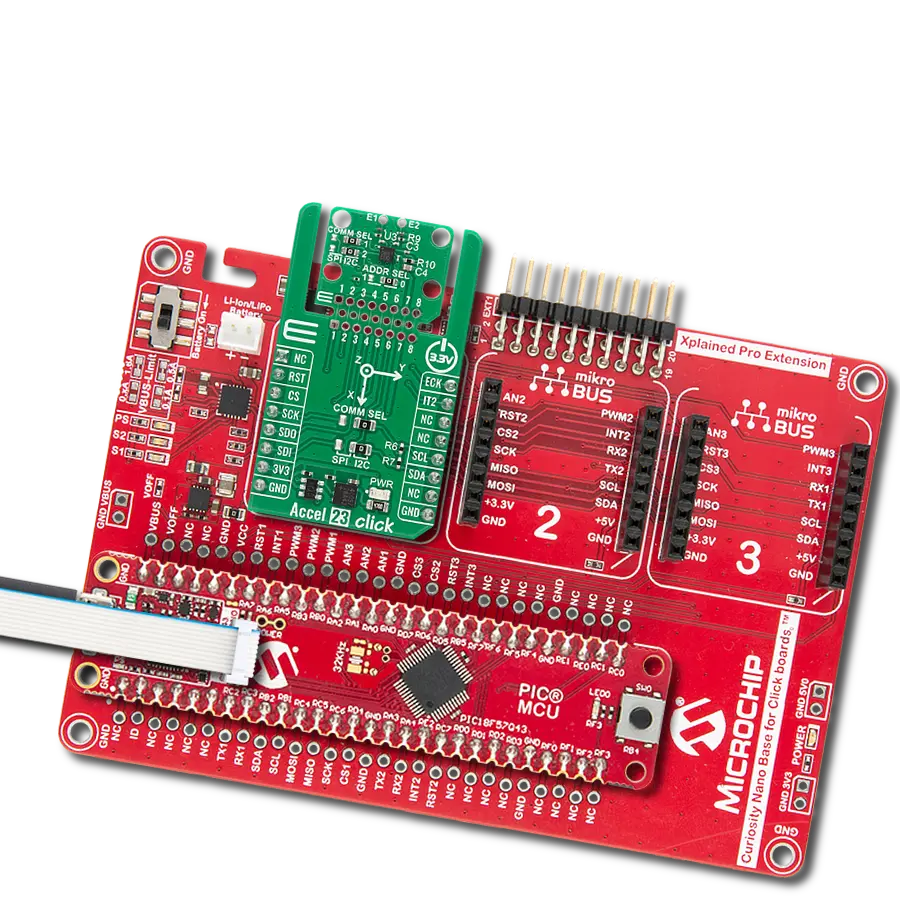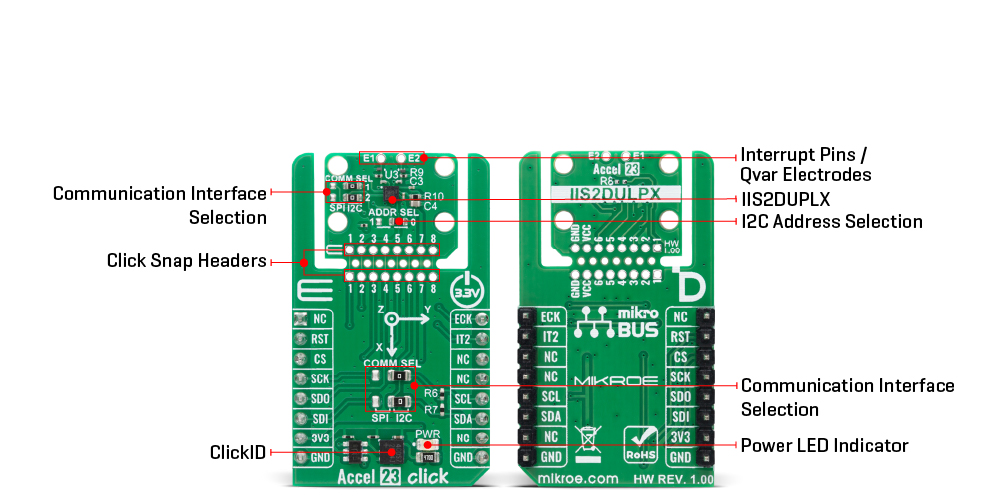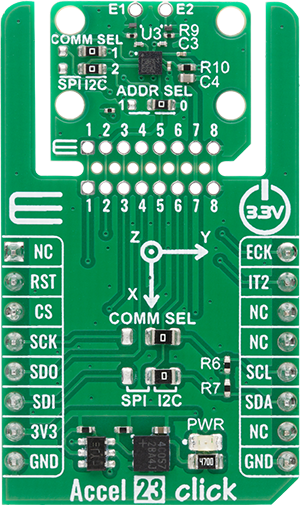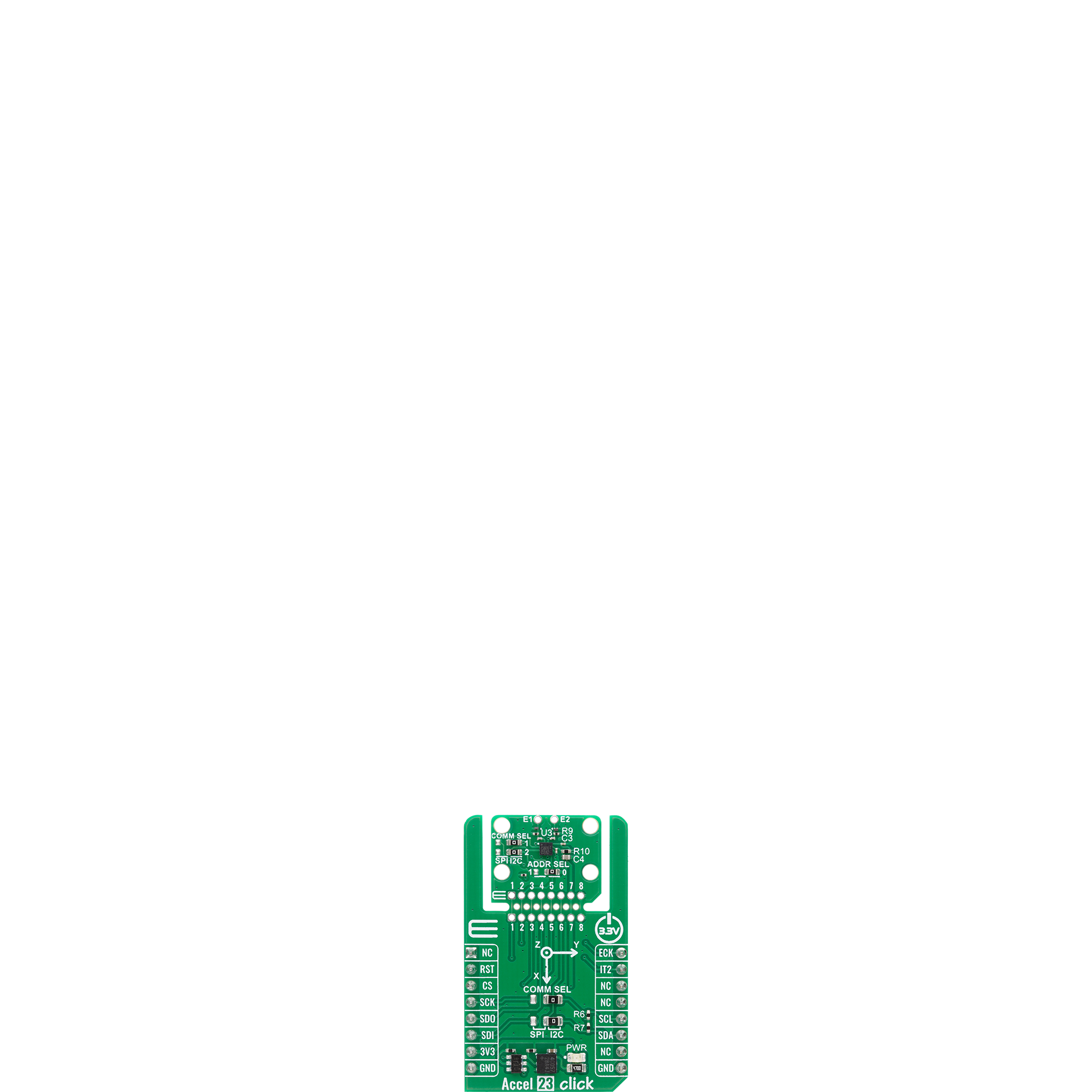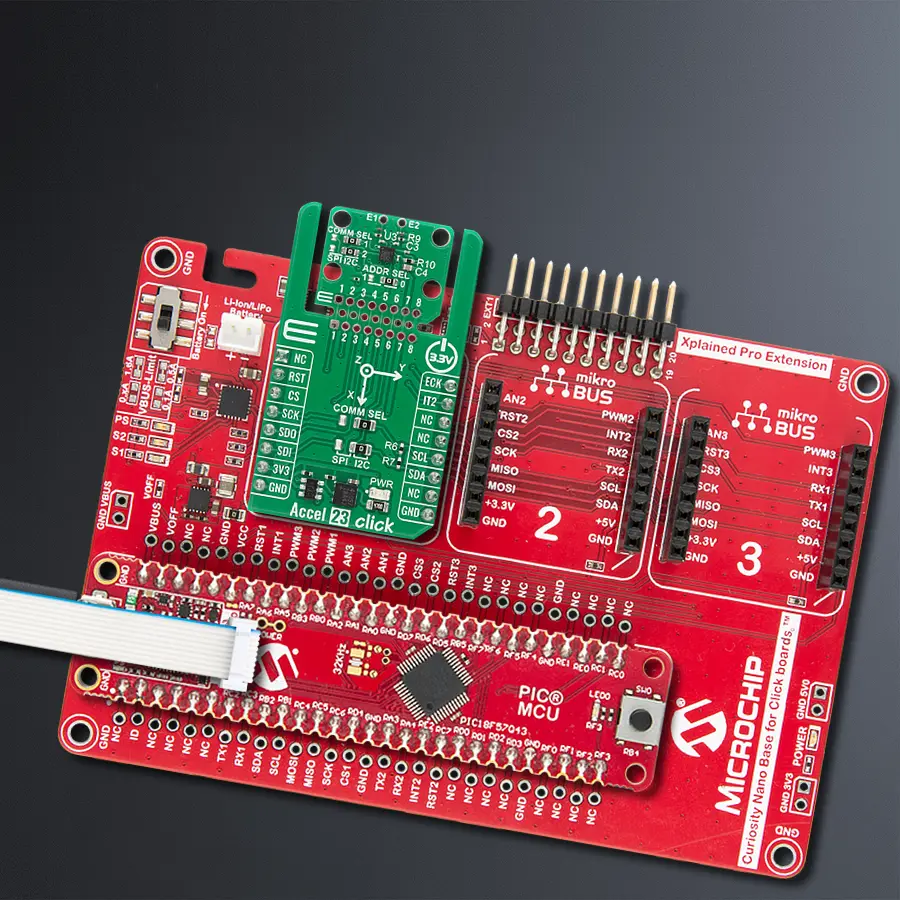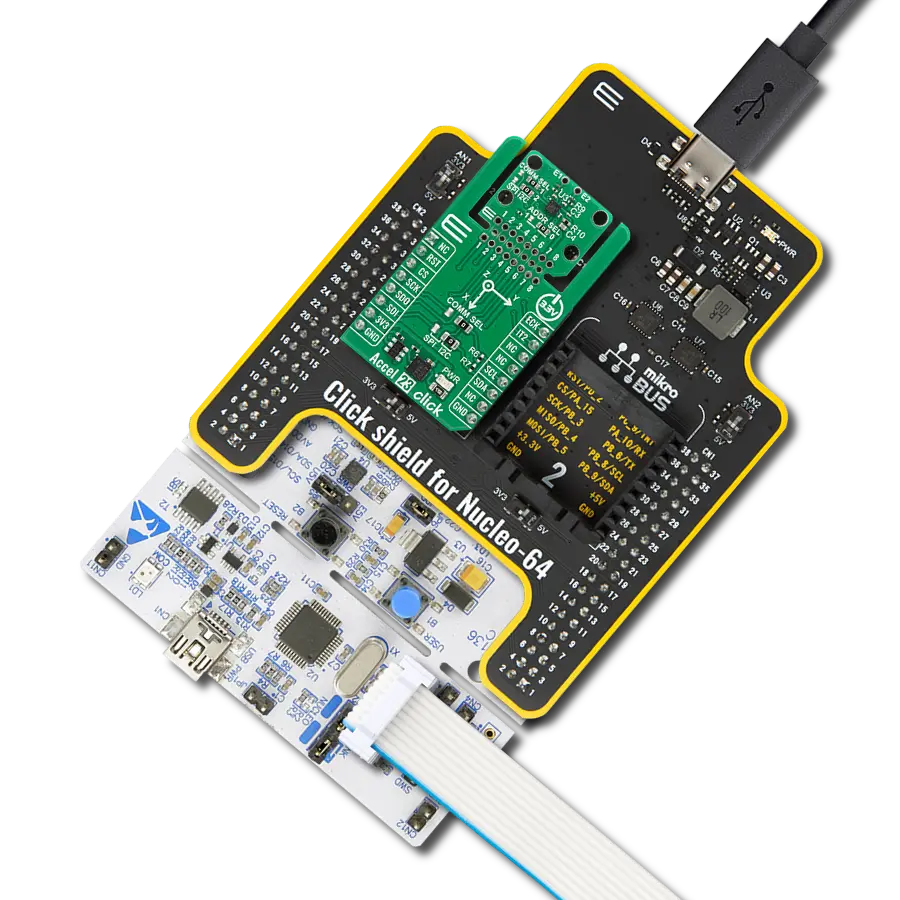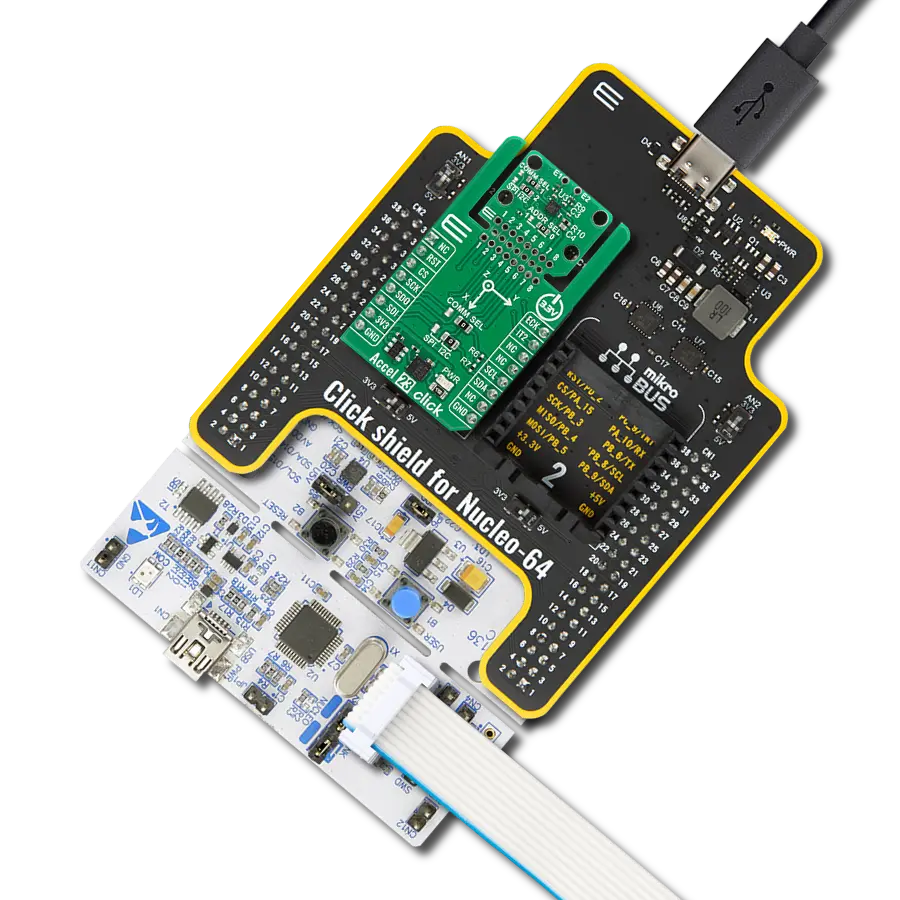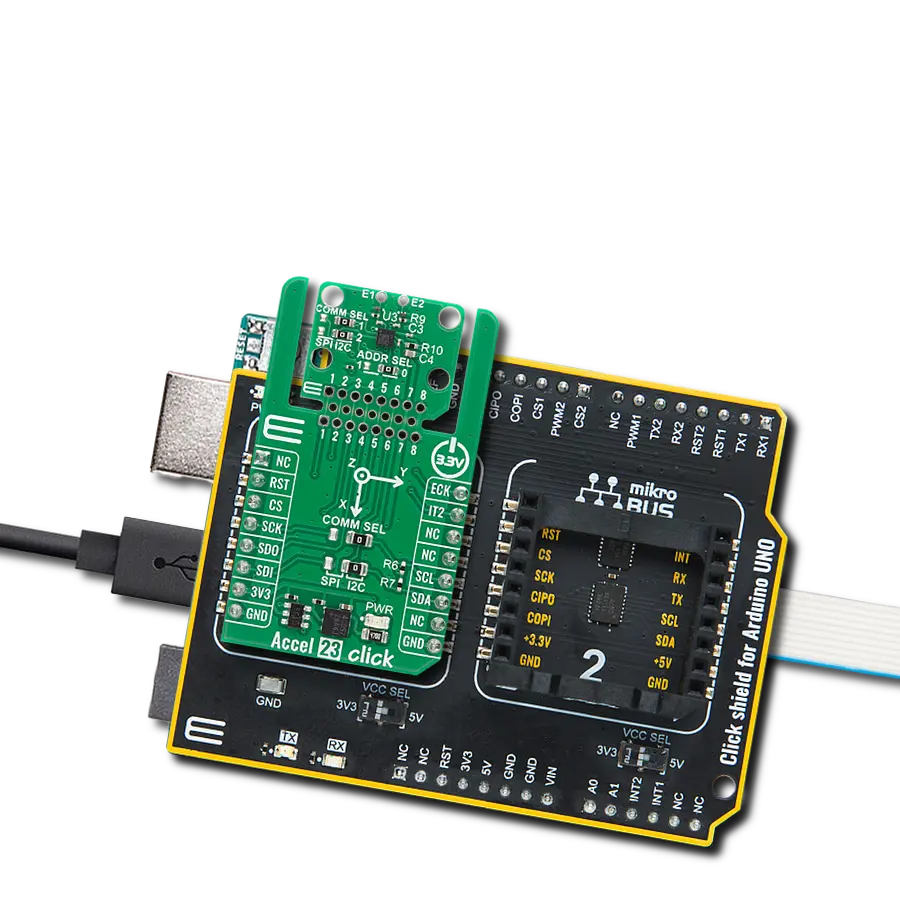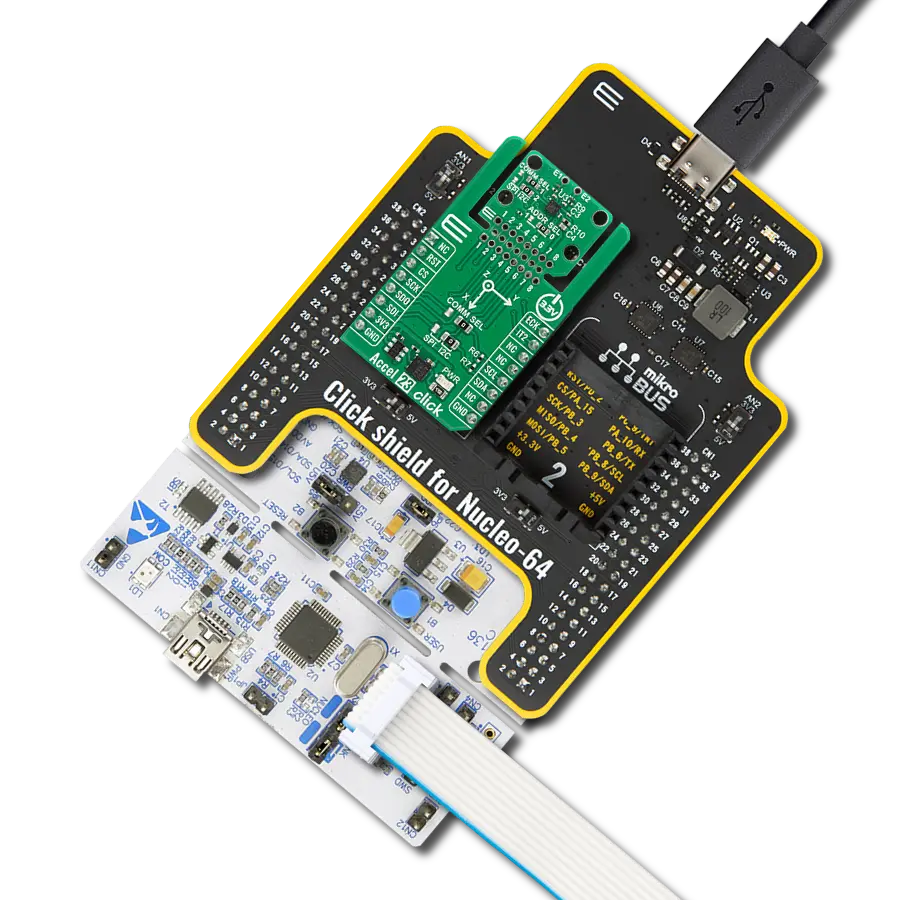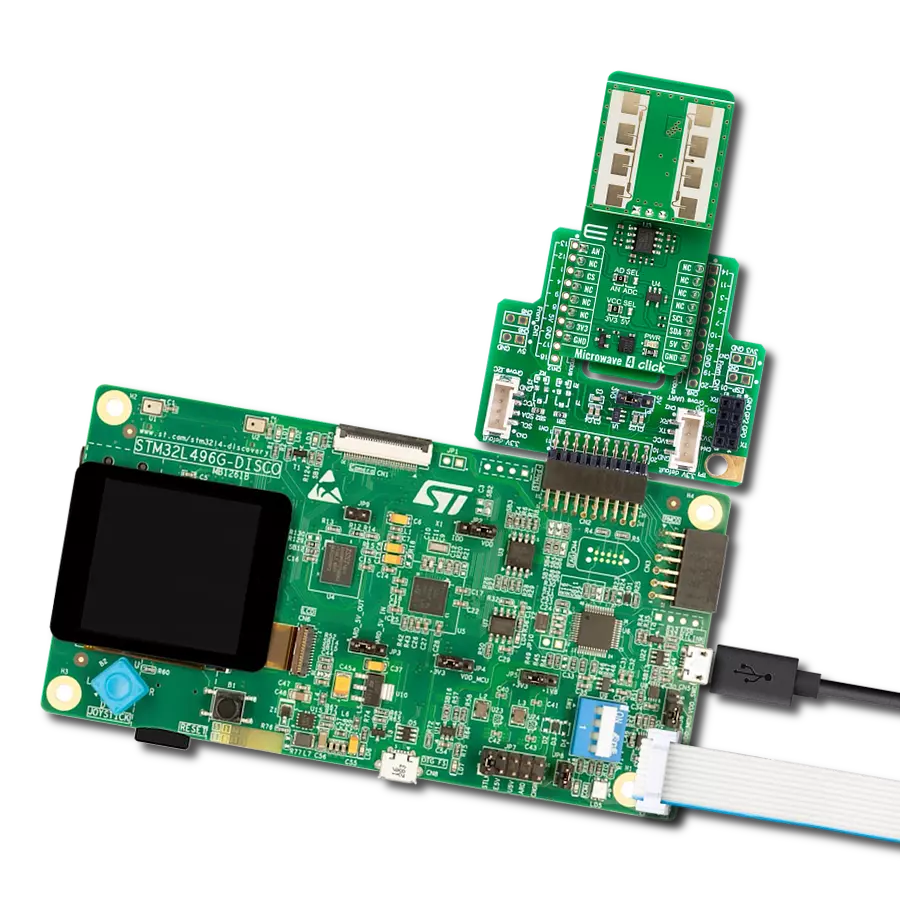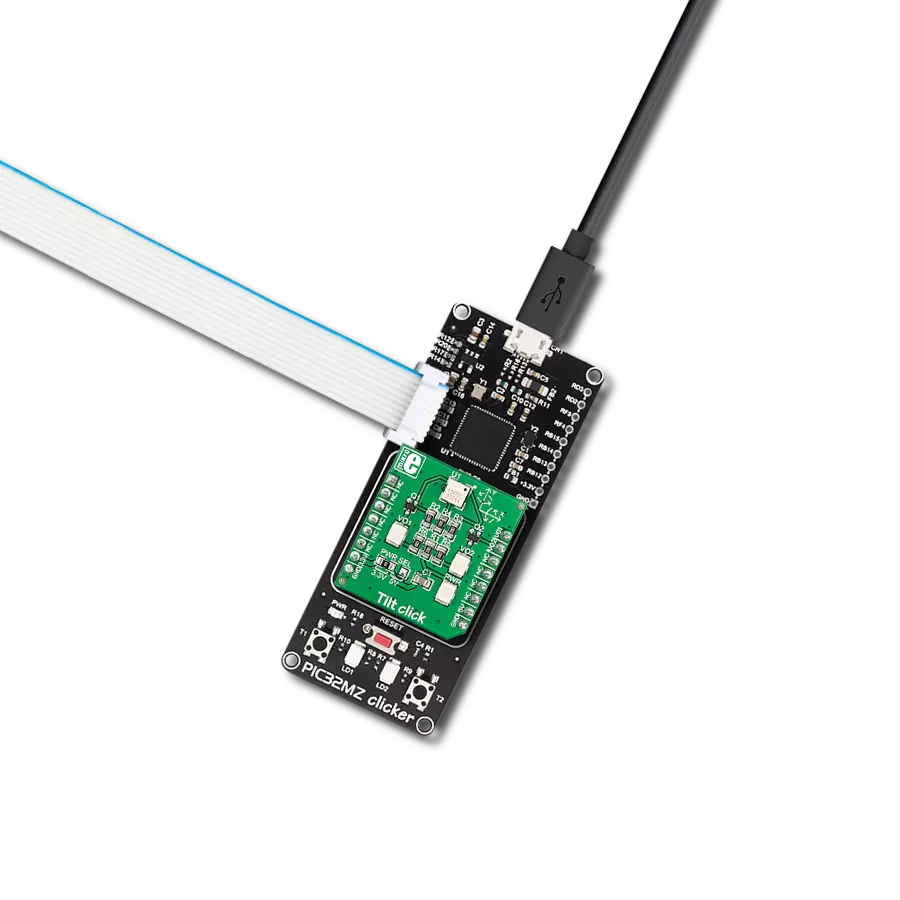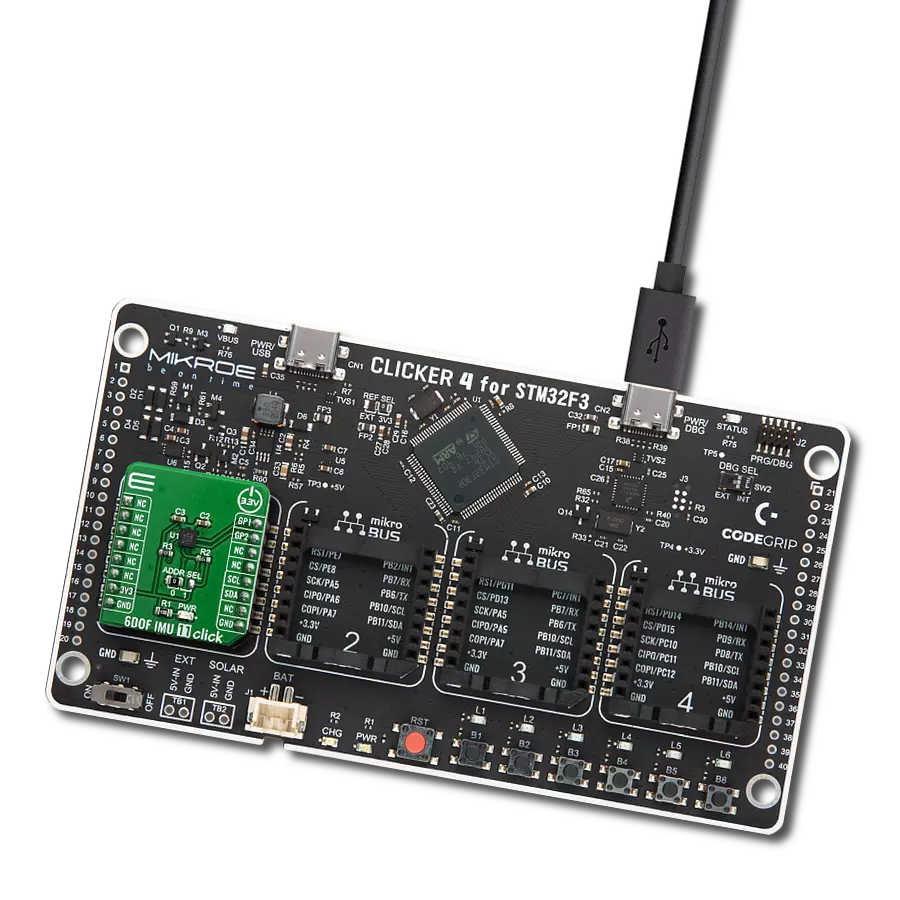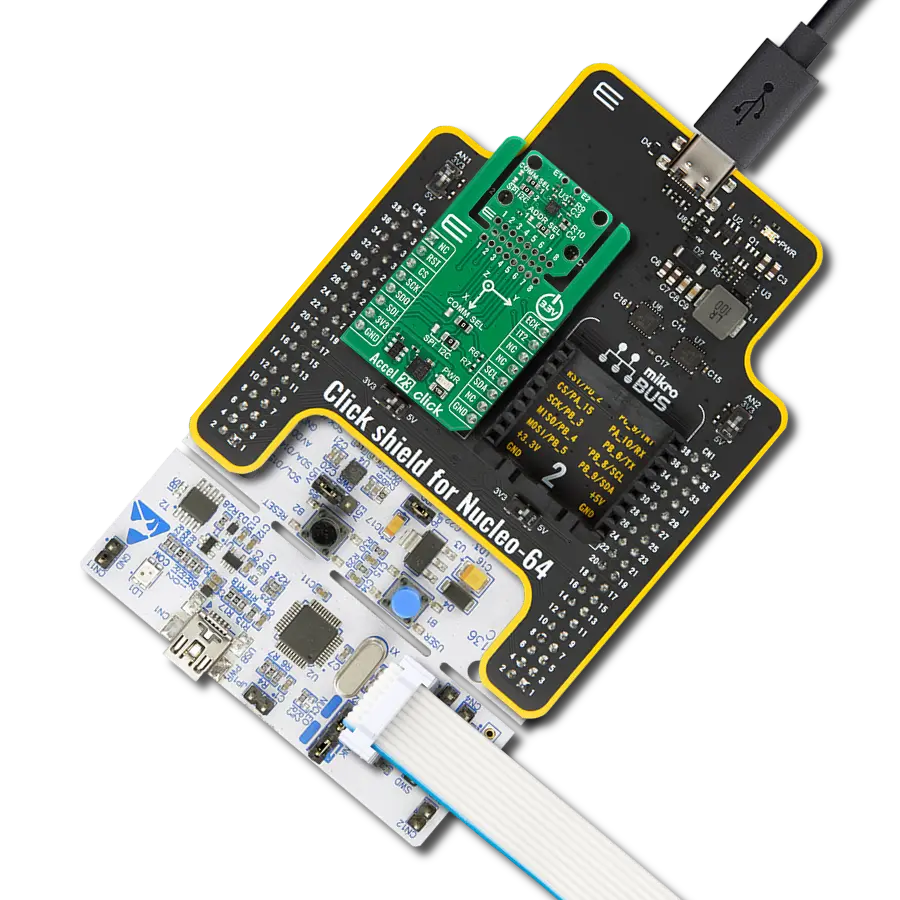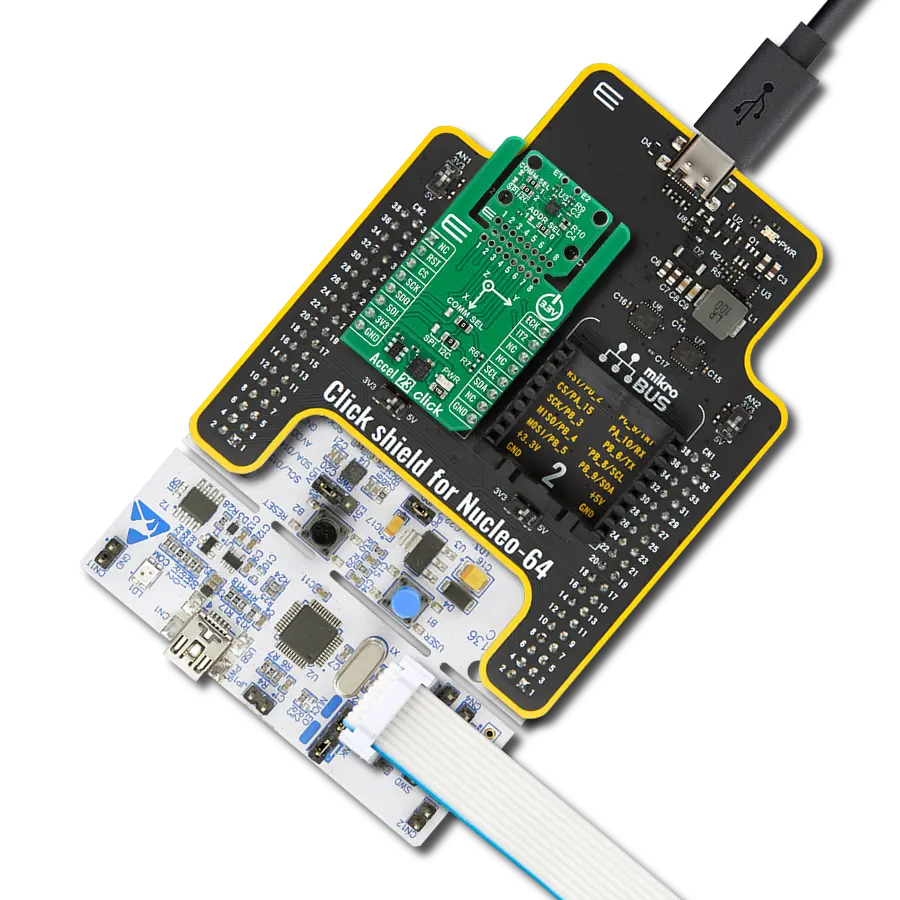Enhance automation and portable embedded applications with advanced motion detection, filtering, and real-time event recognition
A
A
Hardware Overview
How does it work?
Accel 23 Click is based on the IIS2DULPX, an intelligent ultra low-power digital 3-axis linear accelerometer from STMicroelectronics that provides precise motion sensing and advanced edge-processing features for a wide range of industrial and portable applications. The sensor features always-on antialiasing filtering, a programmable finite state machine, and a machine learning core with adaptive self-configuration, enabling local decision-making without the need for constant host intervention. An analog hub with a Qvar sensing channel (E1 and E2 pins) adds a new level of system optimization, while the embedded 128-level FIFO buffer and support for the MIPI I3C target interface further enhance system integration, balancing processing efficiency with ultra-low power operation. The Accel 23 Click is suitable for industrial IoT, factory automation, asset tracking, healthcare wearables, robotics, appliances, and security devices. The IIS2DULPX supports four operating modes including high-performance with antialiasing filter, low-power with antialiasing filter, ultralow-power, and one-shot mode, making it adaptable to diverse energy and performance requirements. It offers user-selectable full scales of ±2g, ±4g, ±8g, and ±16g, with output data rates
ranging from 1.6Hz to 800Hz and bandwidth up to 400Hz, providing flexibility for both slow and fast motion detection. The device integrates a powerful internal engine for motion and acceleration detection, with built-in recognition for free-fall, wake-up, single/double/triple-tap, activity and inactivity, as well as 6D and 4D orientation. It can generate interrupt signals on multiple pins, supporting advanced functionalities such as pedometer, step detection and counting, significant motion detection, and tilt detection, and can store up to 128 accelerometer and temperature samples or up to 256 accelerometer samples in low resolution, along with an external clock input (ECK pin) for perfect synchronization with other devices. This Click board™ is designed in a unique format supporting the newly introduced MIKROE feature called "Click Snap." Unlike the standardized version of Click boards, this feature allows the main sensor/IC/module area to become movable by breaking the PCB, opening up many new possibilities for implementation. Thanks to the Snap feature, the IIS2DULPX can operate autonomously by accessing its signals directly on the pins marked 1-8. Additionally, the Snap part includes a specified and fixed screw hole position, enabling users to
secure the Snap board in their desired location. This board supports communication with the host MCU through either SPI (maximum clock frequency of 10MHz) or I2C (maximum clock frequency of 1MHz) interfaces, with I2C being the default option. The communication interface is selected by adjusting the COMM SEL jumper to the desired position. To enhance flexibility, particularly with the detachable Snap section of the Click Snap format, an additional COMM SEL jumpers are available. These jumpers functions the same as the COMM SEL, allowing for independent communication interface selection when the Snap section is used independently. To ensure proper functionality, all COMM jumpers must be set to the same interface. For those using the I2C interface, the board also provides an ADDR SEL jumper, enabling users to configure the I2C address as needed for their specific application. This Click board™ can be operated only with a 3.3V logic voltage level. The board must perform appropriate logic voltage level conversion before using MCUs with different logic levels. It also comes equipped with a library containing functions and example code that can be used as a reference for further development.
Features overview
Development board
PIC18F57Q43 Curiosity Nano evaluation kit is a cutting-edge hardware platform designed to evaluate microcontrollers within the PIC18-Q43 family. Central to its design is the inclusion of the powerful PIC18F57Q43 microcontroller (MCU), offering advanced functionalities and robust performance. Key features of this evaluation kit include a yellow user LED and a responsive
mechanical user switch, providing seamless interaction and testing. The provision for a 32.768kHz crystal footprint ensures precision timing capabilities. With an onboard debugger boasting a green power and status LED, programming and debugging become intuitive and efficient. Further enhancing its utility is the Virtual serial port (CDC) and a debug GPIO channel (DGI
GPIO), offering extensive connectivity options. Powered via USB, this kit boasts an adjustable target voltage feature facilitated by the MIC5353 LDO regulator, ensuring stable operation with an output voltage ranging from 1.8V to 5.1V, with a maximum output current of 500mA, subject to ambient temperature and voltage constraints.
Microcontroller Overview
MCU Card / MCU

Architecture
PIC
MCU Memory (KB)
128
Silicon Vendor
Microchip
Pin count
48
RAM (Bytes)
8196
You complete me!
Accessories
Curiosity Nano Base for Click boards is a versatile hardware extension platform created to streamline the integration between Curiosity Nano kits and extension boards, tailored explicitly for the mikroBUS™-standardized Click boards and Xplained Pro extension boards. This innovative base board (shield) offers seamless connectivity and expansion possibilities, simplifying experimentation and development. Key features include USB power compatibility from the Curiosity Nano kit, alongside an alternative external power input option for enhanced flexibility. The onboard Li-Ion/LiPo charger and management circuit ensure smooth operation for battery-powered applications, simplifying usage and management. Moreover, the base incorporates a fixed 3.3V PSU dedicated to target and mikroBUS™ power rails, alongside a fixed 5.0V boost converter catering to 5V power rails of mikroBUS™ sockets, providing stable power delivery for various connected devices.
Used MCU Pins
mikroBUS™ mapper
Take a closer look
Click board™ Schematic
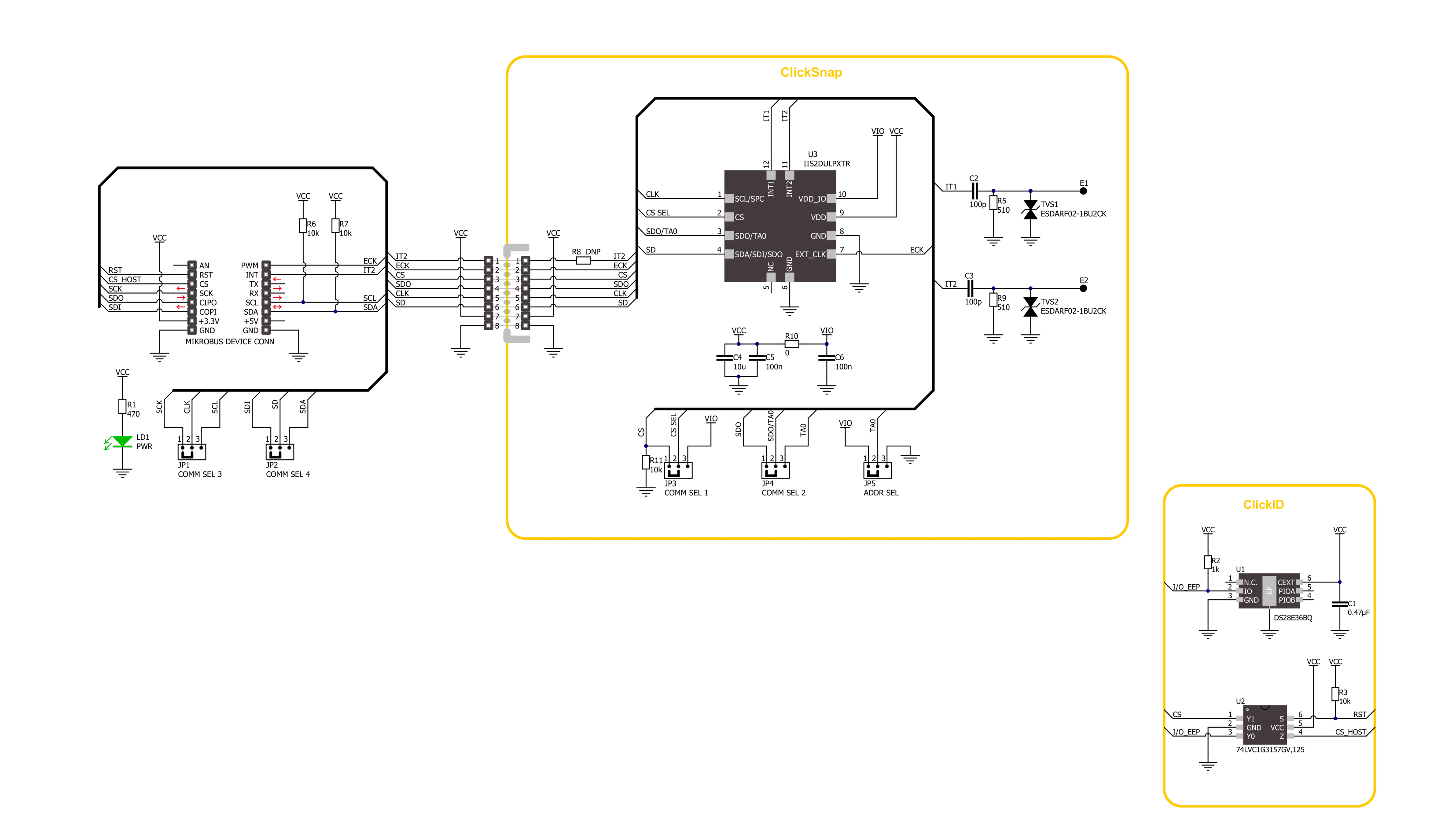
Step by step
Project assembly
Track your results in real time
Application Output
1. Application Output - In Debug mode, the 'Application Output' window enables real-time data monitoring, offering direct insight into execution results. Ensure proper data display by configuring the environment correctly using the provided tutorial.

2. UART Terminal - Use the UART Terminal to monitor data transmission via a USB to UART converter, allowing direct communication between the Click board™ and your development system. Configure the baud rate and other serial settings according to your project's requirements to ensure proper functionality. For step-by-step setup instructions, refer to the provided tutorial.

3. Plot Output - The Plot feature offers a powerful way to visualize real-time sensor data, enabling trend analysis, debugging, and comparison of multiple data points. To set it up correctly, follow the provided tutorial, which includes a step-by-step example of using the Plot feature to display Click board™ readings. To use the Plot feature in your code, use the function: plot(*insert_graph_name*, variable_name);. This is a general format, and it is up to the user to replace 'insert_graph_name' with the actual graph name and 'variable_name' with the parameter to be displayed.

Software Support
Library Description
Accel 23 Click demo application is developed using the NECTO Studio, ensuring compatibility with mikroSDK's open-source libraries and tools. Designed for plug-and-play implementation and testing, the demo is fully compatible with all development, starter, and mikromedia boards featuring a mikroBUS™ socket.
Example Description
This example demonstrates the use of the Accel 23 Click board by reading acceleration and temperature data from the onboard 3-axis accelerometer. The measured values are displayed via the UART terminal.
Key functions:
accel23_cfg_setup- This function initializes Click configuration structure to initial values.accel23_init- This function initializes all necessary pins and peripherals used for this Click board.accel23_default_cfg- This function executes a default configuration of Accel 23 Click board.accel23_get_data- This function retrieves acceleration and temperature data from the device.
Application Init
Initializes the logger and the Click board and applies the default configuration.
Application Task
Reads the acceleration values in X, Y, and Z axis as well as the internal temperature, then displays the results on the UART terminal.
Open Source
Code example
The complete application code and a ready-to-use project are available through the NECTO Studio Package Manager for direct installation in the NECTO Studio. The application code can also be found on the MIKROE GitHub account.
/*!
* @file main.c
* @brief Accel 23 Click example
*
* # Description
* This example demonstrates the use of the Accel 23 Click board by reading
* acceleration and temperature data from the onboard 3-axis accelerometer.
* The measured values are displayed via the UART terminal.
*
* The demo application is composed of two sections :
*
* ## Application Init
* Initializes the logger and the Click board and applies the default configuration.
*
* ## Application Task
* Reads the acceleration values in X, Y, and Z axis as well as the internal
* temperature, then displays the results on the UART terminal.
*
* @author Stefan Filipovic
*
*/
#include "board.h"
#include "log.h"
#include "accel23.h"
static accel23_t accel23;
static log_t logger;
void application_init ( void )
{
log_cfg_t log_cfg; /**< Logger config object. */
accel23_cfg_t accel23_cfg; /**< Click config object. */
/**
* Logger initialization.
* Default baud rate: 115200
* Default log level: LOG_LEVEL_DEBUG
* @note If USB_UART_RX and USB_UART_TX
* are defined as HAL_PIN_NC, you will
* need to define them manually for log to work.
* See @b LOG_MAP_USB_UART macro definition for detailed explanation.
*/
LOG_MAP_USB_UART( log_cfg );
log_init( &logger, &log_cfg );
log_info( &logger, " Application Init " );
// Click initialization.
accel23_cfg_setup( &accel23_cfg );
ACCEL23_MAP_MIKROBUS( accel23_cfg, MIKROBUS_1 );
err_t init_flag = accel23_init( &accel23, &accel23_cfg );
if ( ( I2C_MASTER_ERROR == init_flag ) || ( SPI_MASTER_ERROR == init_flag ) )
{
log_error( &logger, " Communication init." );
for ( ; ; );
}
if ( ACCEL23_ERROR == accel23_default_cfg ( &accel23 ) )
{
log_error( &logger, " Default configuration." );
for ( ; ; );
}
log_info( &logger, " Application Task " );
}
void application_task ( void )
{
accel23_data_t meas_data;
if ( ACCEL23_OK == accel23_get_data ( &accel23, &meas_data ) )
{
log_printf( &logger, " Accel X: %.3f g\r\n", meas_data.accel.x );
log_printf( &logger, " Accel Y: %.3f g\r\n", meas_data.accel.y );
log_printf( &logger, " Accel Z: %.3f g\r\n", meas_data.accel.z );
log_printf( &logger, " Temperature: %.2f degC\r\n\n", meas_data.temperature );
Delay_ms ( 80 );
}
}
int main ( void )
{
/* Do not remove this line or clock might not be set correctly. */
#ifdef PREINIT_SUPPORTED
preinit();
#endif
application_init( );
for ( ; ; )
{
application_task( );
}
return 0;
}
// ------------------------------------------------------------------------ END
Additional Support
Resources
Category:Motion
